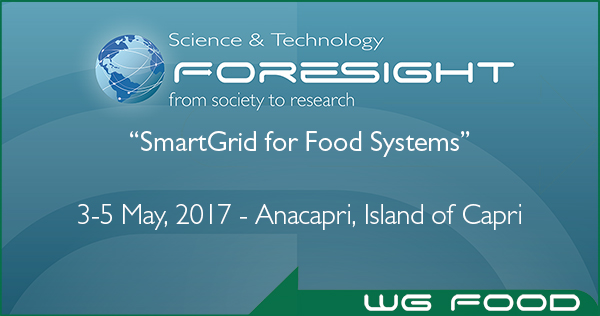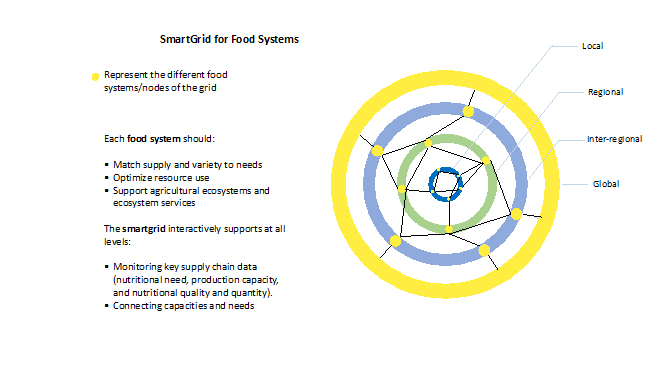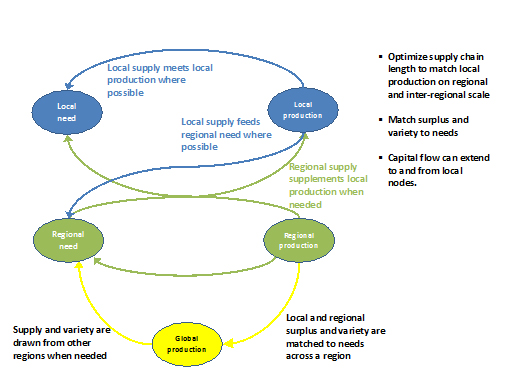 SmartGridforFoodSystems Applying emerging technology to build resilient nutrition supply networks
SmartGridforFoodSystems Applying emerging technology to build resilient nutrition supply networks
3-5 May, 2017 - Anacapri, Island of Capri, Italy
Coordinator: Cecilia Bartolucci
Scientific Committee: David Carlander, Rick Canady, Ralf Greiner
In collaboration with: NeutralScience, www.neutralscience.org
Contact: This email address is being protected from spambots. You need JavaScript enabled to view it.
The concept of “SmartGrid for Food Systems” arose from the need to propose a new approach to the challenge of providing, in a sustainable way, food security and healthy food to a growing population. Malnutrition is prevalent in many parts of the world and predictions are that it will get worse as the population grows. However, there are estimates that caloric production capacity today could easily meet the need in 2050 if we could only match capacity and nutritional quality to the need. Much of the mismatch is because of a wrong quantity/quality ratio, or because areas of need are separated from areas of production. Technology has the potential to allow much more capacity to be produced nearer to the areas of need, supporting local realities and variations (crops, climate, population, culture) according to specific demands.
Adapting local and regional variation in resources and capacity to local and regional need through a smartgrid, will create diversity and resilience in nutrition supply and it can reduce waste and energy needs. Diversity comes from local variation connected to regional and global markets. Resilience comes from networked supply lines to diverse capacity reserves in local, regional, and global networks. Waste reduction and energy savings come from focused application of new energy and water technologies and supply networks that reduce transport and post-harvest loss of yields.
A smartgrid system for nutrition production and supply can be developed by focusing existing and emerging technologies to match capacity and need while balancing resource use in diverse geographic, social and economic conditions.
Benefits of this approach are:
- efficient use of supply chains and capacity
- resilience and sustainability
- distribution of markets and capital flow
- focus for socially beneficial technological growth
Within this frame, the Foresight Group is organizing a workshop on “SmartGrid for Food Systems” to be held on 3-5 May, 2017, Anacapri (Italy). Goal of the workshop is to validate the concept of SmartGrid for Food Systems and to indicate processes and technologies which, in a long term, allow its realization. (For background documents, more details on the Foresight Project, and the methods adopted by the Foresight Group see foresight.cnr.it)
SmartGrid Criteria
A food system is defined as a system that embraces all the elements (environment, people, inputs, processes, infrastructure, institutions, markets and trade) and activities that relate to the production, processing, distribution and marketing, preparation and consumption of food and the outputs of these activities, including socio-economic and environmental outcomes. (HLPE (2014), Report: Food losses and waste in the context of sustainable food systems.)
This definition does not include the variable size (geographical, economical, variety of products or amount produced …). Hence, we can talk about local, regional, inter-regional, or global food systems; a food system responsible for the production of only one product (e.g. apples in South Tirol; sugar cane in Thailand …); or a food system focused on producing food for a specific area such as urban areas. It is fundamental that, whenever we talk about a food system, we consider all elements and all activities as described in the definition above. A food system approach considers also that all food systems are part of the global food system and hence interlinked. The “Smartgrid for Food Systems” exploits this interconnection to create a more balanced, resilient and sustainable global system.
The focus is set on the local food systems (i.e. the local nodes of the smartgrid), and their potential to match local needs to local resources. Local systems are connected to the regional and inter-regional systems (further nodes in the grid) in a dynamic and flexible way. At all levels (from local to global), systems within the grid need to fulfill the following criteria:
- Match supply and variety to needs
- Optimize resource use, both in terms of efficiency and sustainability
- Support agricultural ecosystems and ecosystem services
Fulfilling these criteria while ensuring food security and healthy nutrition can be achieved only through:
- The monitoring and evaluating of local and regional key supply chain data regarding nutritional need, production capacity, and nutritional quality and quantity
- The connection of capacities and needs through a local, regional, and inter-regional distribution network
- The connection of different nodes through monitoring and predicting the smartgrid response to future climatic, environmental and socioeconomic conditions.
- The adaptation of production methods and technologies to resources (locally, regionally, inter-regionally)
 This is conceivable though improvements in agriculture and integration of emerging technologies for food production and processing, materials to process and store food, and technologies for energy and water. New knowledge in the relationship between health and nutrition followed by the development of proper technological applications will also need to be addressed. Furthermore, infrastructure to shorten and optimize paths from production to need can also work in the reverse direction to connect local capacity to regional and global markets and thereby reduce barriers to participation in markets.
This is conceivable though improvements in agriculture and integration of emerging technologies for food production and processing, materials to process and store food, and technologies for energy and water. New knowledge in the relationship between health and nutrition followed by the development of proper technological applications will also need to be addressed. Furthermore, infrastructure to shorten and optimize paths from production to need can also work in the reverse direction to connect local capacity to regional and global markets and thereby reduce barriers to participation in markets.
The Food System grid is complex, unstructured, and the nodes vary in a dynamic way. Acting on one node influences the status of other nodes and above all, it influences the global condition. The inputs for the necessary actions required to achieve the functioning of the grid come alternatively from different nodes, according to changing situations and current realities. The management and success of the grid is possible only through its being able to gather data and act on them, eventually in a predictive way. Hence, the grid needs to be smart. New technologies need to be developed to allow the rapid exchange of data as well as to enable searches to be made through the grid in a fast and efficient manner.
Building case studies
1. Goal of the case studies
Case studies will provide a base for the discussion during the foresight workshop and are the bridge between the current situation and the development of a smartgrid in the long-term future. We are currently choosing three thematic case study groups, relative to three different food systems challenges. Within the same group we will propose at least two separate case studies. To facilitate coordination and collaboration, single case studies within a thematic group will be carried out in the same region/state. This will also facilitate the connection of food systems within a group. It is important to remember that this is a foresight exercise, hence the unanswered questions rising from the case studies are those we are most interested in. We want to identify gaps and barriers preventing the realization of resilient nutrition supply networks and point out to technologies to overcome them.
Themes for the case studies:
- Small farmers’ fruit and vegetable production in Italy: one case study will be on integrated production of fruit in Emilia Romagna and South Tyrol, a second case study on vegetable production in Puglia.
- Urban agriculture in the US: we have contacts with groups working on urban agriculture in Berkeley, Boston.
- Impact of climate change on crop production: in Bali we want to carry out case studies regarding the impact of climate change and social change, e.g. tourism, on agricultural production. A second case studies will regard rice production in Senegal.
The themes for the case studies are different, yet when integrated into a food system approach, they are related to each other. Each food system analyzed in each case study represents a node in the grid. Evaluating ways of connecting the nodes represents the first step in creating the grid itself.
Before the workshop, we need to describe and map the single food systems (see points below), addressing strength and criticalities of the current approach. Furthermore, we want to have proposals on how these systems could be optimized through their integration into a smartgrid. In order to do that, we want to point out technologies that need to be developed and/or integrated to allow a smartgrid system to be created.
A concise report of the case studies should be provided to all workshop participants prior to the meeting. Specific challenges and highlights of each single case study (or case study group) will be briefly introduced during the workshop. A group of scientific multidisciplinary experts, representatives of governmental institutions, industries, policy makers, and NGOs, will evaluate the proposals and discuss their applicability, pointing out priorities and knowledge gaps that need to be filled.
The first beneficiaries of the results are those who developed the case studies. They will have an immediate, multidisciplinary, international response, and a validation of their proposals. Most important however, the local communities, which are at the bases of the case studies, should be the first repository of the targeted innovation and application of newly developed technologies.
Coordinator Working Group Food: Cecilia Bartolucci
Foresight Project Coordinator: Ezio Andreta
Foresight Project Scientific Director: Giorgio Einaudi
In collaboration with: Richard Canady, NeutralScience, www.neutralscience.org
Organizing committee:
Cecilia Bartolucci This email address is being protected from spambots. You need JavaScript enabled to view it.
IlariaSantoni This email address is being protected from spambots. You need JavaScript enabled to view it..it


